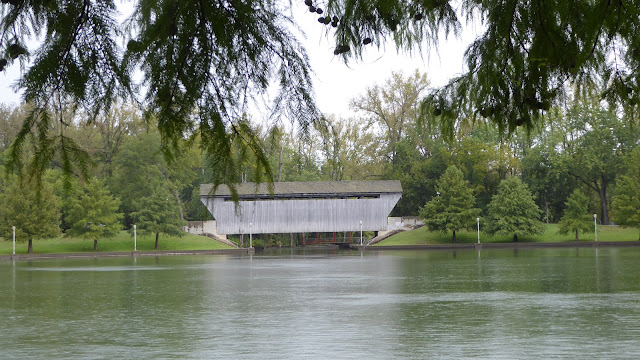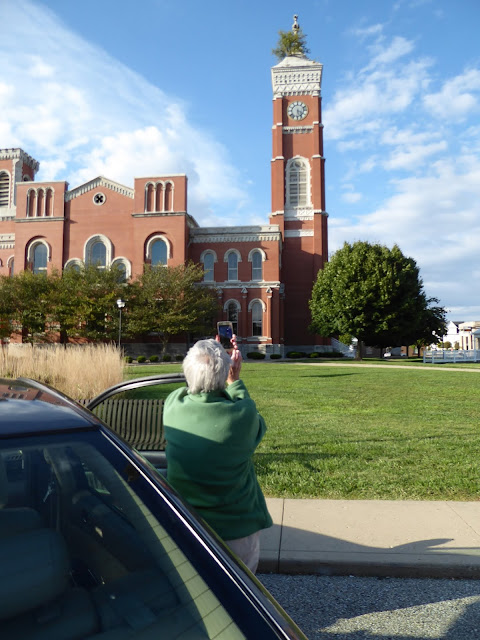Due to COVID-19, the Creighton sisters (my aunts Barb and Deb) have not visited each other since October 2019. One sister lives in the United States and the other one lives in Canada. The borders between the two countries have been closed to non-essential travel since March 2020.
Barb and Deb have had to rely on regular telephone conversations and during a recent call, they reminisced about that time back in September (28-29) 2016 when they both headed off to Indiana to see how many covered bridges they could visit.
The "Indiana Covered Bridges Road Trip" was a trip rich in wonderful memories for the two sisters and this is a photo record of that trip.
"Our main quest was to find covered bridges", said Deb, "of course this took us miles and miles through the backroads of rural Indiana - Gods country! In the middle of nowhere!"
First Barb and Deb purchased a map of The Indiana Covered Bridge Loop which stops at 9 different covered bridges spread throughout 6 counties in Central Indiana. In total, there are 98 historic wooden covered bridges in the state of Indiana. and fourteen of these bridges were built before 1870!
First stop was the Bean Blossom Bridge built by Captain Joseph Balsey in 1880, which is a pedestrian bridge spanning Bean Blossom Creek. (MAP: 4619 Covered Bridge Rd, Nashville, IN 47448)
Captain Joseph Balsey built the bridge in 1880 for $1,200. The 101-foot-long, single Howe through-truss bridge is one of only three left in the state, County Historian Diana Biddle said.
In 2012, the average daily traffic on it was 38 cars — plus the hikers, geocachers and photographers who visit on foot.
The next covered bridge Deb and Barb visited was the Ramp Creek Covered Bridge built by Henry Wolfe in 1838
It's two great accomplishments are that it is the only double tunnel covered bridge in Indiana (and one of four in the U.S.) as well as the oldest covered bridge still standing in Indiana.
Built in 1838, it was originally in Putnam County and was relocated in 1932 to where it is now.
Deb and Barb visited the New Brownsville Covered Bridge which is "the focal point of a beautiful circular pond in the award-winning
Mill Race Park, created by the legendary landscape designer Michael Van
Valkenburgh. The hundred-foot bridge is the only long-truss structure in
Indiana and it can transport you all the way back to 1840, when it was
built to cross the East Fork of the Whitewater River near Brownsville."(Source: https://columbus.in.us/bridges/)
There was no problem finding delicious food along the way..... they stayed the evening of Sept 28th at the Hilton Garden Inn in Edinburgh, Indiana (compliments of Barb's son)
.... and they found plenty of Hoosier hospitality everywhere they went!
The next bridge on the route was the Medora Covered Bridge which is the longest covered bridge in the United States
with the entire original historic truss still in place with some
repairs but no structural changes.
It has been reported but not verified that at one time there was wooden railing down the middle of the bridge separating the two way traffic. As the vehicles became wider, the railing was removed and it was then one way.
The Medora Covered Bridge was built in 1875 by J.J. Daniels at a cost of $18,142.00 and took nine months to build.
"We were lost and then found our tracks, sometimes with the kind help
of country people, known in Indiana (for 150 years) as "Hoosiers"!" said Deb who recalled a few of the people who pointed the way to the next bridge.
"At first glance, the old wood structure bridge, that seemed to be falling
apart, was definitely a sight for sore eyes. But then you realize that
that old bridge had its hay day. It's done its good job. At that
moment, that old bridge was definitely photo worthy!" said Deb.
The next stop was the Scipio Covered Bridge
Built between 1886 and 1887, the bridge is about 124 feet long and was made using the Howe Truss design, which was popular in that day. A construction company out of Toledo did the job for $600.
Locals know to honk their horn as they're going around the curve or while they're inside the bridge to warn possible oncoming traffic that they are coming into or exiting the bridge.
Listed on the National Register of Historic Places, this bridge sees about 50 vehicles per day and is a popular place for stylish photos.
The country roads took Barb and Deb along the plentiful corn fields which lined both sides of the road.
The West Port Covered Bridge was the next stop along the way
It was built by A.M. Kennedy and Sons in 1880, and is a single span, Burr arch bridge on limestone abutments. It measures 130 feet long, 16 feet wide and 13 feet high.
It is topped by a gable roof and sided with shiplap siding.
It is one of numerous covered bridges built by A. M. Kennedy & Sons. It was added to the National Register of Historic Places in 1982.
Debbie recalled, "at the end of our adventure, we drove into Greensburg, Indiana and much to
Barb's delight, once we turned the corner, she immediately spotted the
tree on the tower! I had no idea what she was talking about, but she
knew. "
"We luckily spotted a parking spot, pulled in and started taking pictures of this weird tree atop this tower! Barb was excited to see this. Well, apparently the tree grows out of the top of the Greensburg, Indiana courthouse tower, and had for over 100 years!"
Debbie recalled, "I'd look at Barb and say "one more bridge, if you're okay"? She'd say "sure, lets go, if you're okay"!"
Such beautiful memories and photos of the state of Indiana, its historic covered bridges and two sisters who had an adventure they will never forget.











































No comments:
Post a Comment